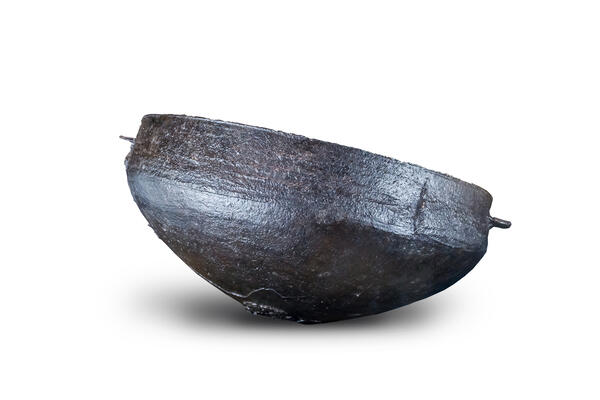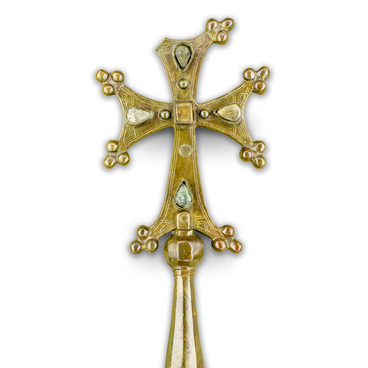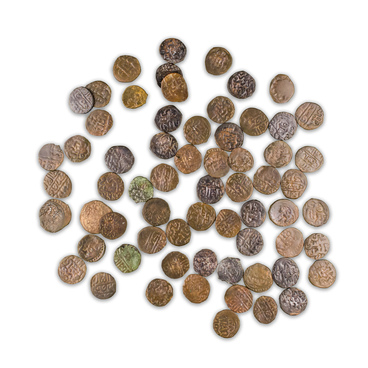Cast iron (‘chugun’ in Russian) appeared in China in the first millennium BC. The name of this material comes from two Chinese words: ‘zhu’ (to cast metal) and ‘gong’ (craft). It was smelted from a mixture of iron and slag (iron balls). The melting point of cast iron ranged from 1150 to 1200 °C, which is 300°C lower than that of pure iron. The craftsmen of the Celestial Empire made weapons and household utensils from it. The expensive cast-iron frying pan ‘wok’ was valuable in the household. It is popular with fans of oriental cuisine in our time. The bottom, narrow in diameter, was combined with thin walls that expand upwards, which made it convenient to cook on a fire.
Cast-iron coins appeared in China at the beginning of the 1st century AD, although most coins continued to be made of bronze until the 19th century. The technology of iron smelting was adopted by the masters of the Golden Horde. In the 14th century, they began to mold cast-iron caldrons. In this very century, various fragments of cast iron, which archaeologists have been finding in the Bolgar ancient settlement, were made.
Scientists suggest that this dating may be incorrect. In fact, cast iron on the territory of the Golden Horde was very expensive, and if the caldron broke, they melted its fragments down and made a new vessel. Perhaps that is why archaeologists have not discovered the earlier fragments yet.
Cast iron products were smelted in almost all major cities of the Golden Horde, including conquered Volga Bulgaria, where they had already learned how to process ferrous metals. Objects were cast in special molds, they were made from a mixture of sand and clay. From the Horde, this technology reached Russian cities. For centuries, cast iron in Russia was molded domestically. In 1701, the Kamensky Iron Foundry in the Urals produced the first batch of cast iron. Here, iron casting became a folk craft, and the openwork cast products of the Kaslinsky plant were renowned not only in Russia but also in European countries. In the 18th century, Russia became the world’s largest producer of cast iron.
The collection of the Bolgar Museum-Reserve shows the visitors the Golden Horde caldron of the 14th century. The item was made in the form of an inverted cone. People used such caldron to heat water or cook food.
Cast-iron coins appeared in China at the beginning of the 1st century AD, although most coins continued to be made of bronze until the 19th century. The technology of iron smelting was adopted by the masters of the Golden Horde. In the 14th century, they began to mold cast-iron caldrons. In this very century, various fragments of cast iron, which archaeologists have been finding in the Bolgar ancient settlement, were made.
Scientists suggest that this dating may be incorrect. In fact, cast iron on the territory of the Golden Horde was very expensive, and if the caldron broke, they melted its fragments down and made a new vessel. Perhaps that is why archaeologists have not discovered the earlier fragments yet.
Cast iron products were smelted in almost all major cities of the Golden Horde, including conquered Volga Bulgaria, where they had already learned how to process ferrous metals. Objects were cast in special molds, they were made from a mixture of sand and clay. From the Horde, this technology reached Russian cities. For centuries, cast iron in Russia was molded domestically. In 1701, the Kamensky Iron Foundry in the Urals produced the first batch of cast iron. Here, iron casting became a folk craft, and the openwork cast products of the Kaslinsky plant were renowned not only in Russia but also in European countries. In the 18th century, Russia became the world’s largest producer of cast iron.
The collection of the Bolgar Museum-Reserve shows the visitors the Golden Horde caldron of the 14th century. The item was made in the form of an inverted cone. People used such caldron to heat water or cook food.



